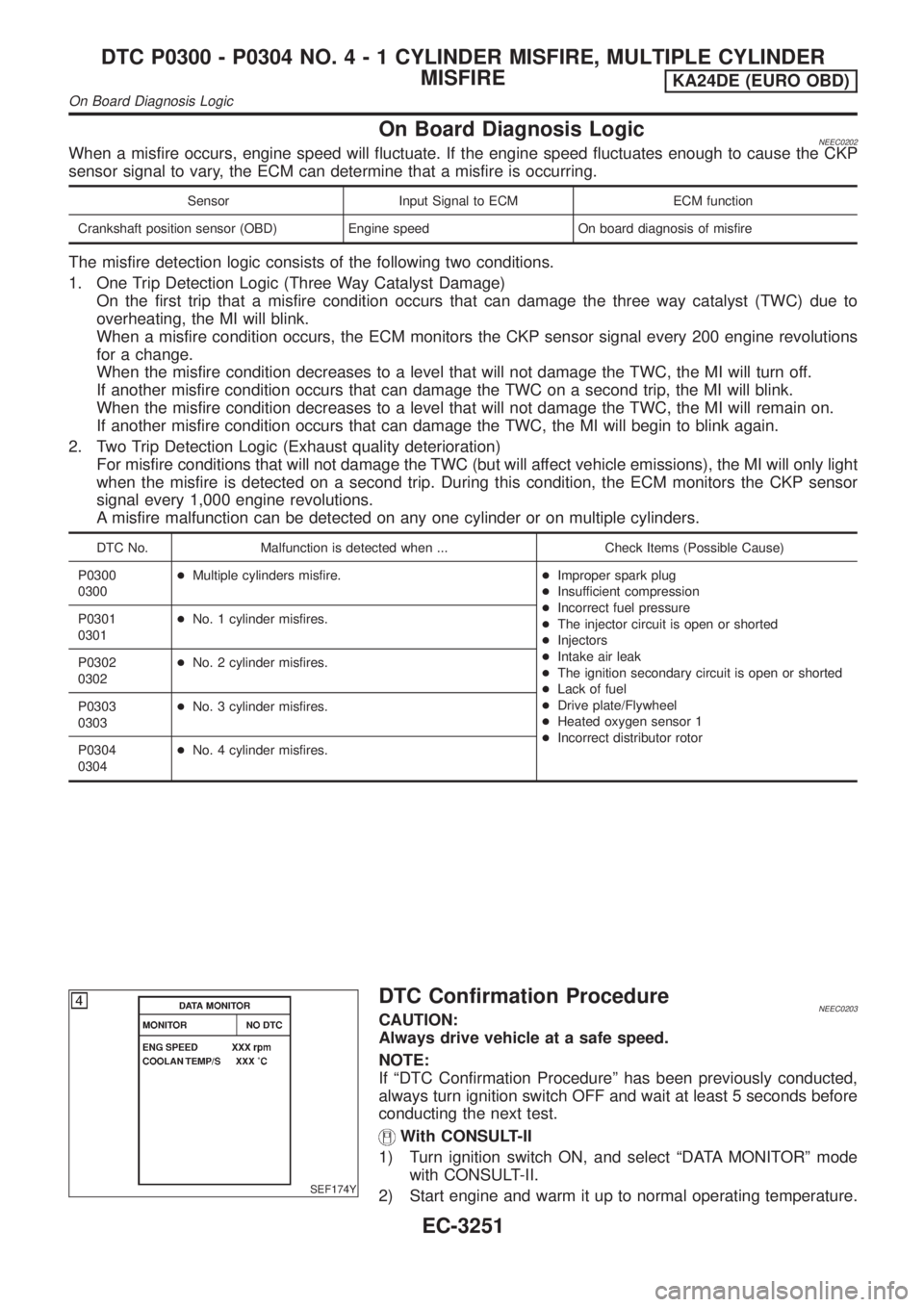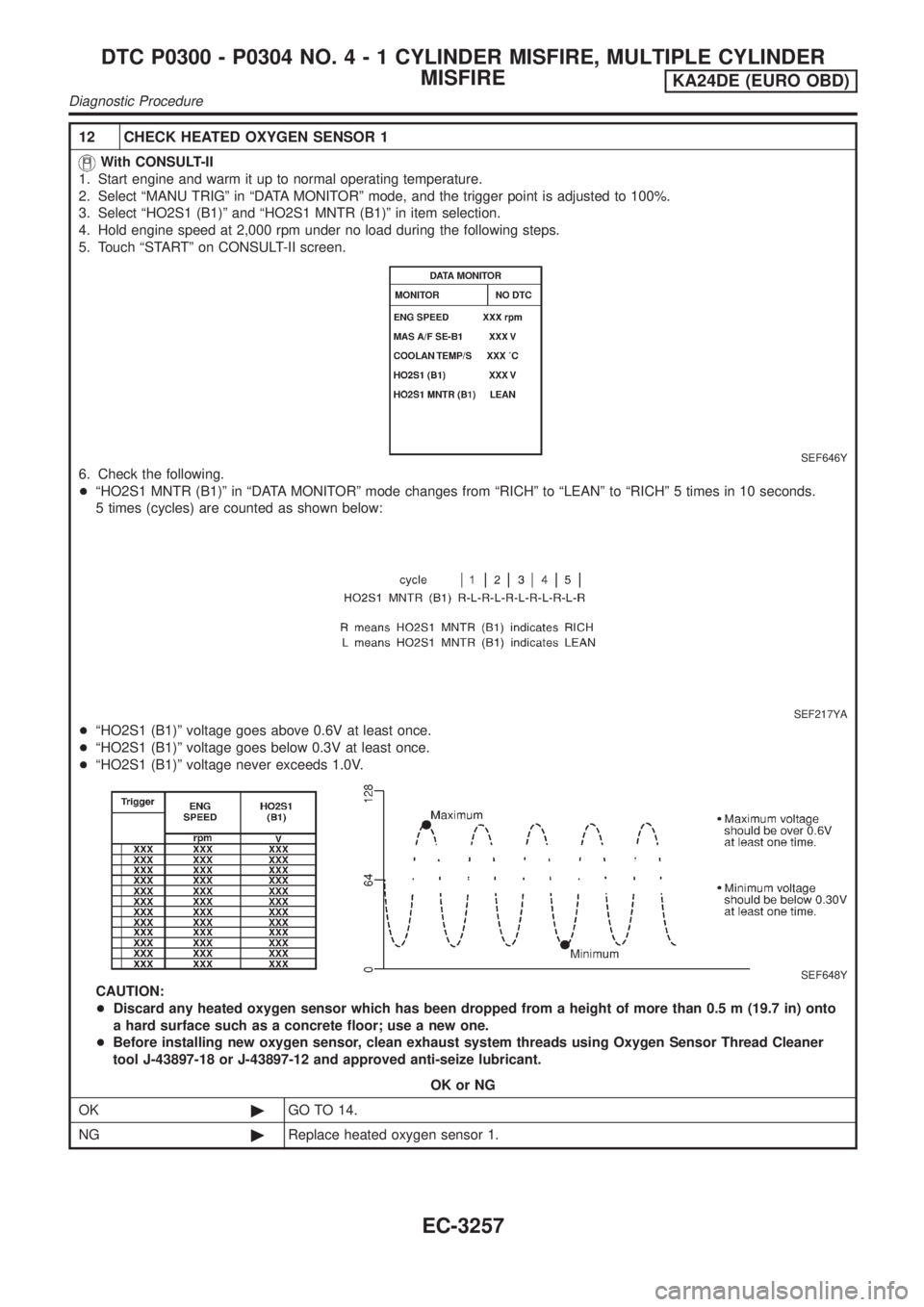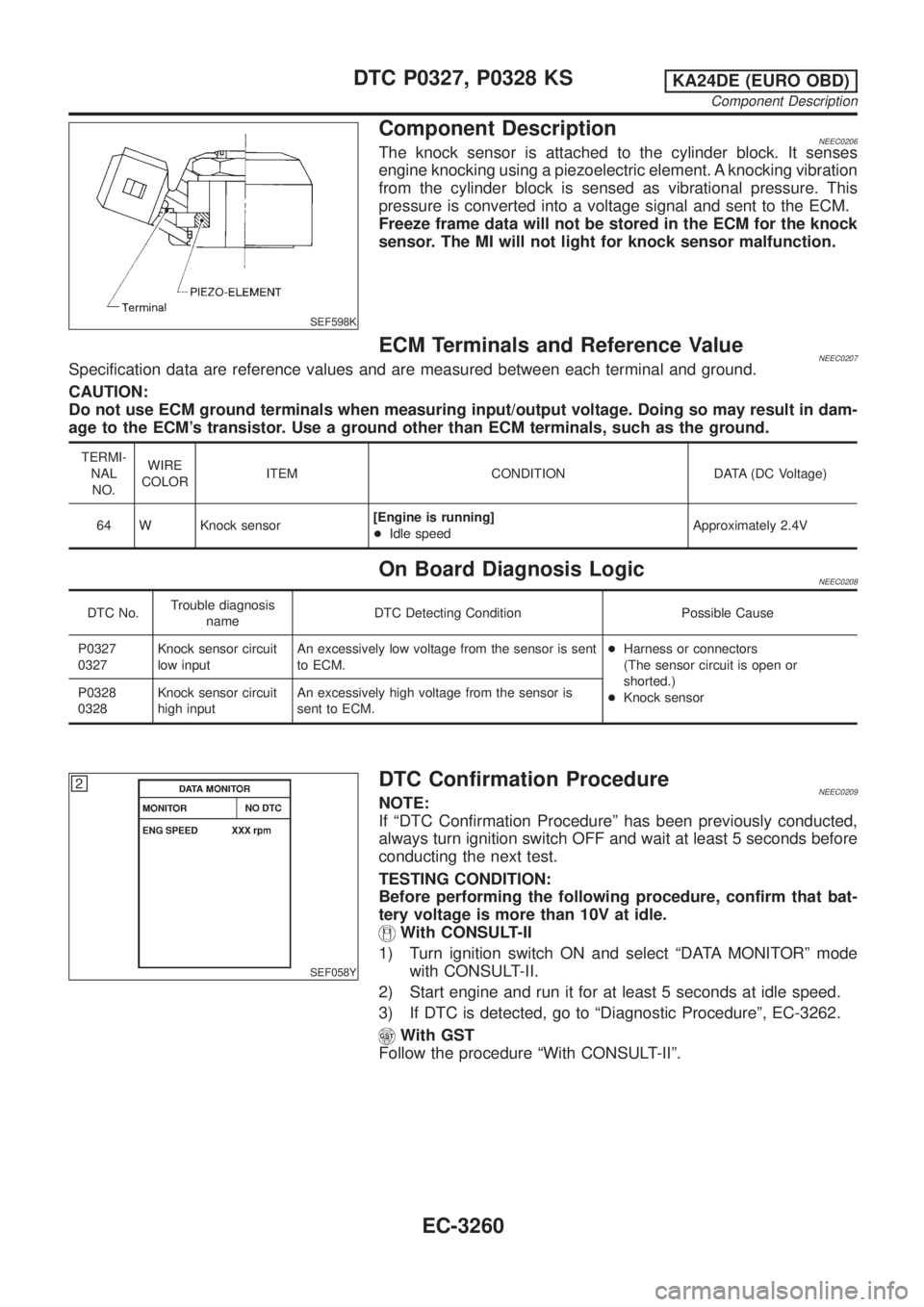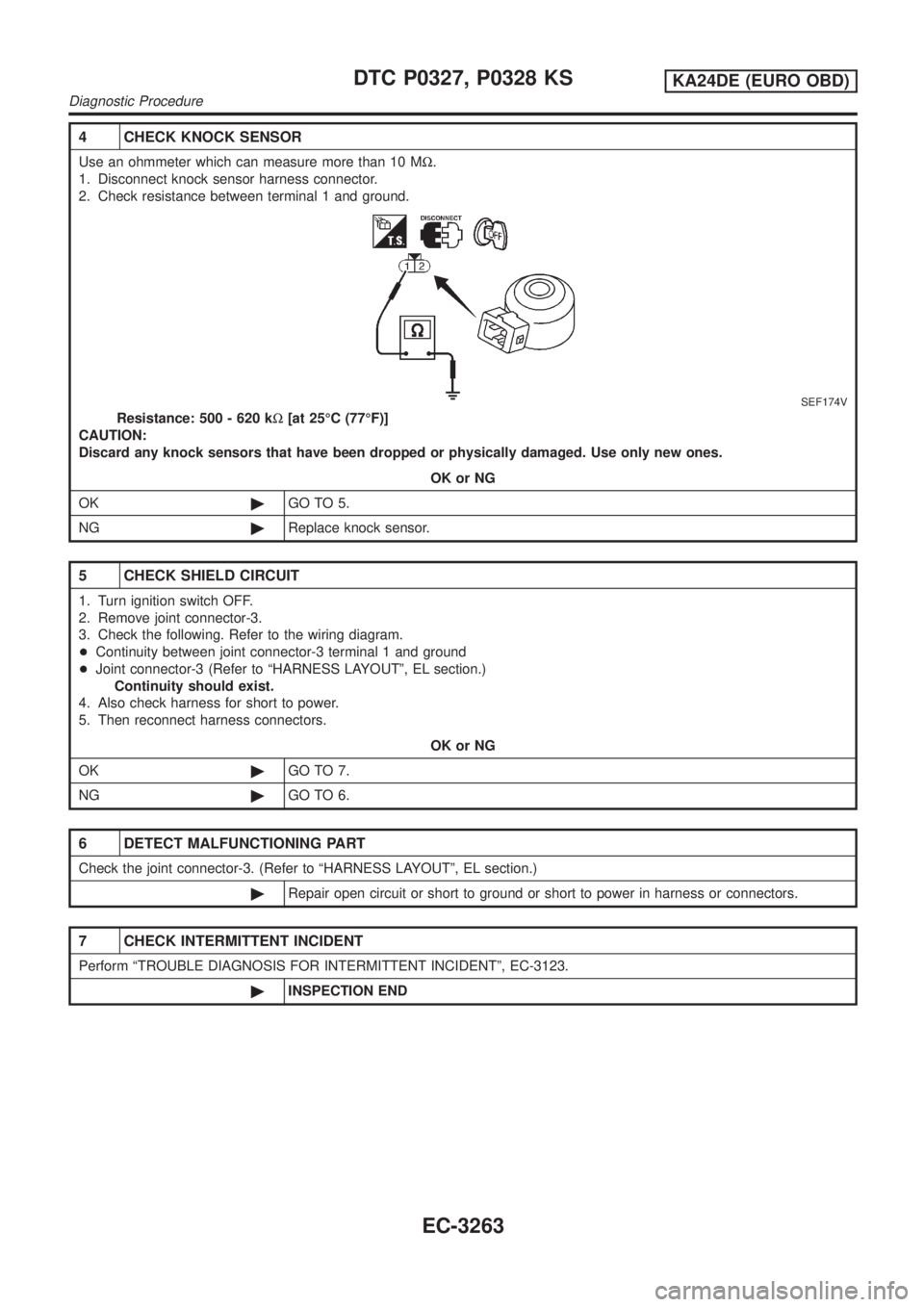2001 NISSAN PICK-UP sensor
[x] Cancel search: sensorPage 272 of 1306

Diagnostic ProcedureNEEC0195
1 CHECK FOR EXHAUST AIR LEAK
1. Start engine and run it at idle.
2. Listen for an exhaust air leak before three way catalyst.
SEF099P
OK or NG
OK©GO TO 2.
NG©Repair or replace.
2 CHECK HEATED OXYGEN SENSOR 1 CIRCUIT
1. Turn ignition switch OFF.
2. Disconnect heated oxygen sensor 1 harness connector and ECM harness connector.
SEF331VC
3. Check harness continuity between ECM terminal 50 and terminal 2. Refer to wiring diagram.
Continuity should exist.
4. Check harness continuity between ECM terminal 50 (or terminal 2) and ground. Refer to wiring diagram.
Continuity should not exist.
5. Also check harness for short to ground and short to power.
OK or NG
OK©GO TO 3.
NG©Repair open circuit or short to ground or short to power in harness or connectors.
DTC P0172 FUEL INJECTION SYSTEM
FUNCTION
KA24DE (EURO OBD)
Diagnostic Procedure
EC-3247
Page 273 of 1306

3 CHECK FUEL PRESSURE
1. Release fuel pressure to zero.
Refer to EC-3033.
2. Install fuel pressure gauge and check fuel pressure.
At idling:
When fuel pressure regulator valve vacuum hose is connected.
Approximately 235 kPa (2.35 bar, 2.4 kg/cm
2, 34 psi)
When fuel pressure regulator valve vacuum hose is disconnected.
Approximately 294 kPa (2.94 bar, 3.0 kg/cm
2, 43 psi)
OK or NG
OK©GO TO 5.
NG©GO TO 4.
4 DETECT MALFUNCTIONING PART
Check the following.
+Fuel pump and circuit (Refer to EC-3378.)
+Fuel pressure regulator (Refer to EC-3034.)
©Repair or replace.
5 CHECK MASS AIR FLOW SENSOR
With CONSULT-II
1. Start engine and warm it up to normal operating temperature.
2. Check ªMASS AIR FLOWº in ªDATA MONITORº mode with CONSULT-II.
at idling: 0.9 - 5.8 g´m/sec
at 2,500 rpm: 7.5 - 13.2 g´m/sec
With GST
1. Start engine and warm it up to normal operating temperature.
2. Check mass air flow sensor signal in MODE 1 with GST.
at idling: 0.9 - 5.8 g´m/sec
at 2,500 rpm: 7.5 - 13.2 g´m/sec
OK or NG
OK©GO TO 6.
NG©Check connectors for rusted terminals or loose connections in the mass air flow sensor
circuit or engine grounds. Refer to EC-3143, EC-3151.
DTC P0172 FUEL INJECTION SYSTEM
FUNCTION
KA24DE (EURO OBD)
Diagnostic Procedure
EC-3248
Page 276 of 1306

On Board Diagnosis LogicNEEC0202When a misfire occurs, engine speed will fluctuate. If the engine speed fluctuates enough to cause the CKP
sensor signal to vary, the ECM can determine that a misfire is occurring.
Sensor Input Signal to ECM ECM function
Crankshaft position sensor (OBD) Engine speed On board diagnosis of misfire
The misfire detection logic consists of the following two conditions.
1. One Trip Detection Logic (Three Way Catalyst Damage)
On the first trip that a misfire condition occurs that can damage the three way catalyst (TWC) due to
overheating, the MI will blink.
When a misfire condition occurs, the ECM monitors the CKP sensor signal every 200 engine revolutions
for a change.
When the misfire condition decreases to a level that will not damage the TWC, the MI will turn off.
If another misfire condition occurs that can damage the TWC on a second trip, the MI will blink.
When the misfire condition decreases to a level that will not damage the TWC, the MI will remain on.
If another misfire condition occurs that can damage the TWC, the MI will begin to blink again.
2. Two Trip Detection Logic (Exhaust quality deterioration)
For misfire conditions that will not damage the TWC (but will affect vehicle emissions), the MI will only light
when the misfire is detected on a second trip. During this condition, the ECM monitors the CKP sensor
signal every 1,000 engine revolutions.
A misfire malfunction can be detected on any one cylinder or on multiple cylinders.
DTC No. Malfunction is detected when ... Check Items (Possible Cause)
P0300
0300+Multiple cylinders misfire.+Improper spark plug
+Insufficient compression
+Incorrect fuel pressure
+The injector circuit is open or shorted
+Injectors
+Intake air leak
+The ignition secondary circuit is open or shorted
+Lack of fuel
+Drive plate/Flywheel
+Heated oxygen sensor 1
+Incorrect distributor rotor P0301
0301+No. 1 cylinder misfires.
P0302
0302+No. 2 cylinder misfires.
P0303
0303+No. 3 cylinder misfires.
P0304
0304+No. 4 cylinder misfires.
SEF174Y
DTC Confirmation ProcedureNEEC0203CAUTION:
Always drive vehicle at a safe speed.
NOTE:
If ªDTC Confirmation Procedureº has been previously conducted,
always turn ignition switch OFF and wait at least 5 seconds before
conducting the next test.
With CONSULT-II
1) Turn ignition switch ON, and select ªDATA MONITORº mode
with CONSULT-II.
2) Start engine and warm it up to normal operating temperature.
DTC P0300 - P0304 NO.4-1CYLINDER MISFIRE, MULTIPLE CYLINDER
MISFIRE
KA24DE (EURO OBD)
On Board Diagnosis Logic
EC-3251
Page 282 of 1306

12 CHECK HEATED OXYGEN SENSOR 1
With CONSULT-II
1. Start engine and warm it up to normal operating temperature.
2. Select ªMANU TRIGº in ªDATA MONITORº mode, and the trigger point is adjusted to 100%.
3. Select ªHO2S1 (B1)º and ªHO2S1 MNTR (B1)º in item selection.
4. Hold engine speed at 2,000 rpm under no load during the following steps.
5. Touch ªSTARTº on CONSULT-II screen.
SEF646Y
6. Check the following.
+ªHO2S1 MNTR (B1)º in ªDATA MONITORº mode changes from ªRICHº to ªLEANº to ªRICHº 5 times in 10 seconds.
5 times (cycles) are counted as shown below:
SEF217YA
+ªHO2S1 (B1)º voltage goes above 0.6V at least once.
+ªHO2S1 (B1)º voltage goes below 0.3V at least once.
+ªHO2S1 (B1)º voltage never exceeds 1.0V.
SEF648Y
CAUTION:
+Discard any heated oxygen sensor which has been dropped from a height of more than 0.5 m (19.7 in) onto
a hard surface such as a concrete floor; use a new one.
+Before installing new oxygen sensor, clean exhaust system threads using Oxygen Sensor Thread Cleaner
tool J-43897-18 or J-43897-12 and approved anti-seize lubricant.
OK or NG
OK©GO TO 14.
NG©Replace heated oxygen sensor 1.
DTC P0300 - P0304 NO.4-1CYLINDER MISFIRE, MULTIPLE CYLINDER
MISFIRE
KA24DE (EURO OBD)
Diagnostic Procedure
EC-3257
Page 283 of 1306

13 CHECK HEATED OXYGEN SENSOR 1
Without CONSULT-II
1. Start engine and warm it up to normal operating temperature.
2. Set voltmeter probes between ECM terminal 50 (Heated oxygen sensor 1 signal) and ECM ground.
AEC873A
3. Check the following with engine speed held at 2,000 rpm constant under no load.
+The voltage fluctuates between 0 to 0.3V and 0.6 to 1.0V more than five times within 10 seconds.
1 time: 0 ± 0.3V®0.6 ± 1.0V®0 ± 0.3V
2 times: 0 ± 0.3V®0.6 ± 1.0V®0 ± 0.3V®0.6 ± 1.0V®0 ± 0.3V
+The maximum voltage is over 0.6V at least one time.
+The minimum voltage is below 0.3V at least one time.
+The voltage never exceeds 1.0V.
CAUTION:
+Discard any heated oxygen sensor which has been dropped from a height of more than 0.5 m (19.7 in) onto
a hard surface such as a concrete floor; use a new one.
+Before installing new oxygen sensor, clean exhaust system threads using Oxygen Sensor Thread Cleaner
tool J-43897-18 or J-43897-12 and approved anti-seize lubricant.
OK or NG
OK©GO TO 14.
NG©Replace heated oxygen sensor 1.
14 CHECK MASS AIR FLOW SENSOR
With CONSULT-II
Check ªMASS AIR FLOWº in ªDATA MONITORº mode with CONSULT-II.
at idling: 0.9 - 5.8 g´m/sec
at 2,500 rpm: 7.5 - 13.2 g´m/sec
With GST
Check mass air flow sensor signal in MODE 1 with GST.
at idling: 0.9 - 5.8 g´m/sec
at 2,500 rpm: 7.5 - 13.2 g´m/sec
OK or NG
OK©GO TO 16.
NG©GO TO 15.
15 CHECK CONNECTORS
Check connectors for rusted terminals or loose connections in the mass air flow sensor circuit or engine grounds.
Refer to EC-3143, EC-3151.
OK or NG
NG©Repair or replace it.
DTC P0300 - P0304 NO.4-1CYLINDER MISFIRE, MULTIPLE CYLINDER
MISFIRE
KA24DE (EURO OBD)
Diagnostic Procedure
EC-3258
Page 285 of 1306

SEF598K
Component DescriptionNEEC0206The knock sensor is attached to the cylinder block. It senses
engine knocking using a piezoelectric element. A knocking vibration
from the cylinder block is sensed as vibrational pressure. This
pressure is converted into a voltage signal and sent to the ECM.
Freeze frame data will not be stored in the ECM for the knock
sensor. The MI will not light for knock sensor malfunction.
ECM Terminals and Reference ValueNEEC0207Specification data are reference values and are measured between each terminal and ground.
CAUTION:
Do not use ECM ground terminals when measuring input/output voltage. Doing so may result in dam-
age to the ECM's transistor. Use a ground other than ECM terminals, such as the ground.
TERMI-
NAL
NO.WIRE
COLORITEM CONDITION DATA (DC Voltage)
64 W Knock sensor[Engine is running]
+Idle speedApproximately 2.4V
On Board Diagnosis LogicNEEC0208
DTC No.Trouble diagnosis
nameDTC Detecting Condition Possible Cause
P0327
0327Knock sensor circuit
low inputAn excessively low voltage from the sensor is sent
to ECM.+Harness or connectors
(The sensor circuit is open or
shorted.)
+Knock sensor P0328
0328Knock sensor circuit
high inputAn excessively high voltage from the sensor is
sent to ECM.
SEF058Y
DTC Confirmation ProcedureNEEC0209NOTE:
If ªDTC Confirmation Procedureº has been previously conducted,
always turn ignition switch OFF and wait at least 5 seconds before
conducting the next test.
TESTING CONDITION:
Before performing the following procedure, confirm that bat-
tery voltage is more than 10V at idle.
With CONSULT-II
1) Turn ignition switch ON and select ªDATA MONITORº mode
with CONSULT-II.
2) Start engine and run it for at least 5 seconds at idle speed.
3) If DTC is detected, go to ªDiagnostic Procedureº, EC-3262.
With GST
Follow the procedure ªWith CONSULT-IIº.
DTC P0327, P0328 KSKA24DE (EURO OBD)
Component Description
EC-3260
Page 287 of 1306

Diagnostic ProcedureNEEC0211
1 RETIGHTEN GROUND SCREWS
Loosen and retighten engine ground screws.
SEC309D
©GO TO 2.
2 CHECK INPUT SIGNAL CIRCUIT-1
1. Turn ignition switch OFF.
2. Disconnect ECM harness connector.
3. Check harness continuity between ECM terminal 64 and ground.
SEF173V
Resistance: Approximately 500 - 620 kW[at 25ÉC (77ÉF)]
It is necessary to use an ohmmeter which can measure more than 10 MW.
4. Also check harness for short to ground and short to power.
OK or NG
OK©GO TO 4.
NG©GO TO 3.
3 CHECK KNOCK SENSOR INPUT SIGNAL CIRCUIT FOR OPEN AND SHORT-II
1. Disconnect knock sensor harness connector.
2. Check harness continuity between ECM terminal 64 and knock sensor terminal 1. Refer to wiring diagram.
Continuity should exist.
3. Also check harness for short to ground and short to power.
OK or NG
OK©GO TO 4.
NG©Repair open circuit or short to ground or short to power in harness or connectors.
DTC P0327, P0328 KSKA24DE (EURO OBD)
Diagnostic Procedure
EC-3262
Page 288 of 1306

4 CHECK KNOCK SENSOR
Use an ohmmeter which can measure more than 10 MW.
1. Disconnect knock sensor harness connector.
2. Check resistance between terminal 1 and ground.
SEF174V
Resistance: 500 - 620 kW[at 25ÉC (77ÉF)]
CAUTION:
Discard any knock sensors that have been dropped or physically damaged. Use only new ones.
OK or NG
OK©GO TO 5.
NG©Replace knock sensor.
5 CHECK SHIELD CIRCUIT
1. Turn ignition switch OFF.
2. Remove joint connector-3.
3. Check the following. Refer to the wiring diagram.
+Continuity between joint connector-3 terminal 1 and ground
+Joint connector-3 (Refer to ªHARNESS LAYOUTº, EL section.)
Continuity should exist.
4. Also check harness for short to power.
5. Then reconnect harness connectors.
OK or NG
OK©GO TO 7.
NG©GO TO 6.
6 DETECT MALFUNCTIONING PART
Check the joint connector-3. (Refer to ªHARNESS LAYOUTº, EL section.)
©Repair open circuit or short to ground or short to power in harness or connectors.
7 CHECK INTERMITTENT INCIDENT
Perform ªTROUBLE DIAGNOSIS FOR INTERMITTENT INCIDENTº, EC-3123.
©INSPECTION END
DTC P0327, P0328 KSKA24DE (EURO OBD)
Diagnostic Procedure
EC-3263